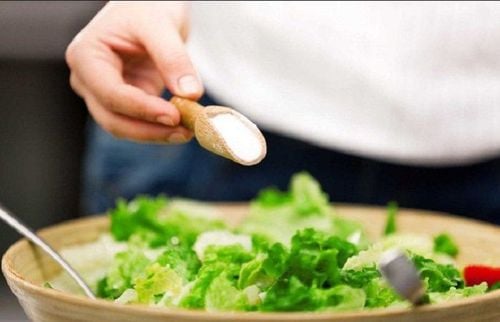This is an automatically translated article.
As a parent or caregiver, you play an important role in helping your child build skills and healthy eating habits. Healthy eating isn't just about what kids eat, it's also about how they eat. This article helps provide necessary information about nutrition for children under 3 years old
1. What foods should you give your child?
You should feed your child the same healthy foods as you and the rest of your family. Offer your child foods with different flavors and textures. Includes:
Vegetables and fruits Whole grain foods like pasta and whole grain breads, oats, barley and quinoa Protein foods like meat, fish, poultry, dried beans , peas, lentils, nut and nut butters, tofu, eggs, milk, yogurt, cheese and fortified soy beverages Eating iron-rich foods helps prevent iron deficiency and supports growth and development brain development. Foods rich in iron include meat, fish, poultry, iron-fortified infant cereals, eggs, tofu, dried beans, peas and lentils. Offer your child these foods at each meal. Make sure the food you offer is prepared with little or no added salt or sugar. Include foods high in healthy fats like salmon, avocados, and nut butters.
2. What should you give your child to drink?
You can continue to breastfeed until your baby is 2 years old or older.
Whole cow's milk and fortified soy drinks are nutritious drinks that provide calcium, vitamin D and protein for growing babies.
Offer 500mL of pasteurized whole cow's milk (3.25% milk fat) per day
Once your child is 2 years old, you can start offering lower fat dairy options like skim, 1% or 2%. You can also give fiber-fortified soy water
Give your child no more than 750mL (3 cups) of soy milk and beverage per day so your child has enough room for a variety of healthy foods, including iron-rich foods
Offer only milk or soy beverages (for children over 2 years old) with meals and snacks
If your child does not drink whole cow's milk or soy beverages , talk to your health care provider or a dietitian about what you can offer instead.
Rice, potato, almond, coconut, oat and hemp drinks are low in protein and fat and do not support the growth of young children.
Give water between meals and snacks. Water is the best beverage when your child is thirsty.
Use an opened cup instead of a "alcohol" cup or bottle when you give it to your child. An open cup will help your child learn to drink water. It also reduces the risk of tooth decay.
Children do not need sugary drinks like pop, sports drinks, juices, fruit drinks and fruit flavored drinks made from powder or crystals. Sugary drinks will fill your child's stomach, replacing healthier foods. All juices, including 100% juice, are high in sugar and low in fiber. Instead, give your child whole fruit.

Cung cấp 500mL sữa bò nguyên chất tiệt trùng (3,25% chất béo sữa) mỗi ngày
3. When should you feed your baby?
Feed your child 3 small meals and 2 to 3 snacks, about 2 to 3 hours apart. Try to have your child eat meals and snacks at the same time each day. A regular routine of meals and snacks can help your child form healthy eating habits.
4. How much food does the child need?
Every child is different and the amount of food they need varies based on their age, activity level, growth rate and appetite. It's normal for your child's appetite to change from day to day. Your child's appetite can also be influenced by mood, health, time of day, and food offered.
Start by offering small amounts at meals and snacks and let your child ask for more.
5. What can you do to help your child eat well?
Eat with your child
You are your child's best role model. Your child will learn healthy eating habits by watching you. Always supervise your child while eating.
Feed your baby new foods many times
Regularly introduce new foods and offer at least one type of food that your child eats well. Children often need to see, smell, and touch a food many times before tasting it. Your child may have to taste a food several times before eating it. Continue to offer new foods and include foods your child has refused before.
Feed your baby enough time
Your baby may take longer to eat than you. Give them time to finish eating. If your child shows you that they've finished eating by playing with food, let them leave the table to enjoy a book or a toy.
Letting your child feed himself
Letting your child feed himself is an important part of learning how to eat. Young children learn by touching, smelling, tasting and looking at food. Learning how to use a spoon and fork takes time. Making a mess is also part of learning how to eat.
Keep mealtimes calm and reduce distractions
Turn off TVs, cell phones, tablets and computers so kids can focus on eating and keep family meals pleasant. This will also help you focus on enjoying time together, not on what or how much your child eats.
Try offering the same food in different ways
Be patient. Offer your child foods prepared in a variety of ways. Sautéed vegetables, chopped vegetables in soups or pasta sauces, and smoothies made with fruits and vegetables are delicious ways to offer a wider variety of foods. If your child likes vegetables cooked a certain way, offer them other vegetables that are also cooked that way.

Thường xuyên cho trẻ ăn thức ăn mới và cho trẻ ăn ít nhất 1 loại thức ăn mà trẻ ăn tốt
6. What if your child doesn't want to eat?
If your child is growing well, occasional skipping meals should not be a concern. If you have questions about your child's growth, appetite, or intake, talk to your healthcare provider or a registered dietitian.
If your child doesn't want to eat a certain food, discard the food and wait until the next meal or snack to offer them again. Making your child another meal will not help them become a healthy eater.
Sometimes young children just want to eat the same foods over and over. This is normal and may last for several weeks or months. If “favorite” foods are healthy, continue to offer them along with a variety of other healthy foods. If “favorite” foods are a less healthy choice, offer them less often.
No need to use dessert or favorite food as a reward for eating. Do not force your child to eat. Trust your child's appetite to guide your child whether or not to eat and how much to eat.
For children to be healthy and develop well, it is necessary to have a nutritious diet in terms of quantity and quality balance. If children are not provided with adequate and balanced nutrients, it will lead to diseases of excess or lack of nutrients, which adversely affect the comprehensive development of children in terms of physical, mental and motor skills.
Children who do not eat properly are at risk of micro-mineral deficiency causing anorexia, growth retardation, malabsorption,... If they notice the above signs, parents should supplement their children with products. The supplement contains lysine, essential micro-minerals and vitamins such as zinc, chromium, selenium, and B vitamins to help fully meet the nutritional needs of children. At the same time, these essential vitamins also support digestion, enhance nutrient absorption, help improve anorexia, and help children eat well.
Parents can learn more:
Signs of zinc deficiency in children
Micronutrient deficiency and failure to gain weight in children
Please regularly visit Vinmec.com website and update useful information to take care of your child. Take care of the baby and the whole family.
Reference source: viendinhduong.vn













